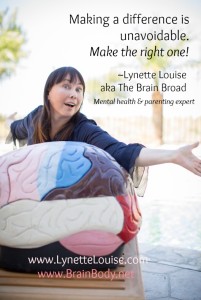Apparently, I like the number five when inspiring people to grow. For example, I have a show called Fix It In Five and I wrote Five Steps To Self Discovery in my new book Inspire Yourself To Greatness Change Your Brain Change the World. I even rewrote the number five in The Seven Senses of Leadership: The Brain Broad’s Guide To Leadership Sensibilities by shifting the normally believed in sensory system senses from five to seven. (When you tell people there are seven they automatically think of the number five.)
When it comes to numbers and being heard by the populace there is an actual science. Five, seven, nine, ten, and eleven top the list depending on the purpose of the list. Generally speaking, lower numbers are better in to-do/not-to-do and “why” lists, whereas higher numbers are better for accomplishments like the top ten charities, etc. For me, the number five seems most compelling because it implies enough work to make a difference and not so much work that you can’t remember all the steps or risk getting overwhelmed just reading the list. When it comes to “reasons why” this is even more true. Too few reasons won’t get me to reduce my bank account by more than a few dollars and too many reasons has an implied message that tells me I am super broken and need way more than five days for the fix (and, oh ya, the retreat is five days long).
What retreat you ask?
Why, the one in Mexico of course 🙂
My last five days this October will be spent rejuvenating brains and bodies at a beachfront luxury villa located in the exclusive neighborhood of Punta Mita on the Pacific Coast of Mexico. Alongside Dianne Kosto (founder of SYMMETRY Neuro-Pathway Training) and Dana James (founder of the Archetype Diet), we’ll be using our expertise and passion to give you the tools and experiences needed to Change Your Mindset To Change Your Life. I invite you to join us. You see, to really become better, more you, happier, and healthier, your psychology AND your physiology must shift in unison. And THAT is easiest done away from home in a soothing environment.
Whether you are facing anxiety, burn-out, overwhelm, sleep problems, health issues or a few stubborn extra pounds; this experience will prove that changing the way you think really can change everything.
Enjoy accommodation in a luxury, beachfront villa in paradise.
So, here you go. Five Reasons You Should Spend Five Days at our Neurofeedback & Nutrition Retreat this October:
1- The price of the retreat is cheaper than the two QEEG tests and various sessions you will receive would be if you bought them individually. So if you have been wanting to test neurofeedback this is an amazing opportunity! Normally, to get neurofeedback the provider requires these tests AND a minimum number of pre-purchased sessions. This is a huge commitment for the person just deciding if the therapy is right for them.
2- An unfamiliar yet supportive environment removes the usual habit forming behavioral cues and allows you to dig deep and rewrite old beliefs that are causing barriers to your development. Having neurofeedback sessions at the same time enables you to balance your physiology and correct for minor functional issues that have been impeding your growth and challenging your focus. For example, for some people feeling stressed results in a type of targeting behavior that means the person will look for who to attack. Removing that stress without balancing the brain leaves them feeling frightened as if they were in a stranger’s body. People who are like this find it hard to enjoy relaxing. However, with both neurofeedback and a supportive environment – away from the usual triggers – relaxing becomes rejuvenating
3- As mentioned, change can be stressful. But with neurofeedback that stress is reduced. And then living in a state of comfort helps solidify the desired feelings and behaviors. Thus, being surrounded by balancing techniques and activities (beaches, boats, yoga, infra-red sauna, massage, etc) facilitates the changes while allowing you to eliminate the difficulties.
4- The setting is beautiful yet separate from the town. It is secure and operates like an oasis for you and the other participants to recreate themselves in. This, and the neurofeedback accompanied by teaching and testing, magnifies the possibilities and enables people to accomplish for themselves in five days what it would normally require months to do.
5– The participant list will remain small to allow for intimacy and full access to experts. Though intentional change is possible in large gatherings the potential for emotional damage is high. In smaller groups, we can assist you as you choose and even attain your own personal self-discovery goals. We have small groups in order to ensure your success.
Of course, there are many more than five reasons to join us. And many of those reasons will be of a more personalized nature. So I encourage you to imagine yourself there, check out our itinerary, the menu, the photos of the villa, and picture how you might personally benefit. What you may want to work on or examine.
Feel free to make your own list of all the reasons you should spend five days at our neurofeedback and nutrition retreat this October. May I offer a fun suggestion?
Make it a list of five. 😉


 For a while.
For a while.
